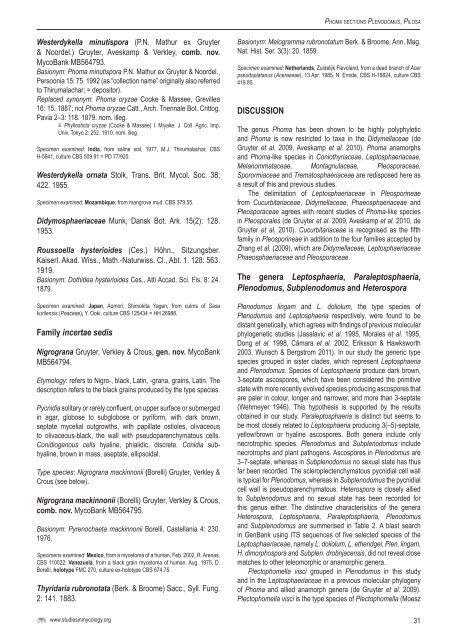redisposition of Phoma-like anamorphs in Pleosporales - CBS - KNAW
redisposition of Phoma-like anamorphs in Pleosporales - CBS - KNAW
redisposition of Phoma-like anamorphs in Pleosporales - CBS - KNAW
Create successful ePaper yourself
Turn your PDF publications into a flip-book with our unique Google optimized e-Paper software.
<strong>Phoma</strong> sections Plenodomus, Pilosa<br />
Westerdykella m<strong>in</strong>utispora (P.N. Mathur ex Gruyter<br />
& Noordel.) Gruyter, Aveskamp & Verkley, comb. nov.<br />
MycoBank MB564793.<br />
Basionym: <strong>Phoma</strong> m<strong>in</strong>utispora P.N. Mathur ex Gruyter & Noordel.,<br />
Persoonia 15: 75. 1992 (as “collection name” orig<strong>in</strong>ally also referred<br />
to Thirumalachar; = depositor).<br />
Replaced synonym: <strong>Phoma</strong> oryzae Cooke & Massee, Grevillea<br />
16: 15. 1887; not <strong>Phoma</strong> oryzae Catt., Arch. Triennale Bot. Crittog.<br />
Pavia 2–3: 118. 1879. nom. illeg.<br />
≡ Phyllosticta oryzae (Cooke & Massee) I. Miyake. J. Coll. Agric. Imp.<br />
Univ. Tokyo 2: 252. 1910. nom. illeg.<br />
Specimen exam<strong>in</strong>ed: India, from sal<strong>in</strong>e soil, 1977, M.J. Thirumalachar, <strong>CBS</strong><br />
H-5941, culture <strong>CBS</strong> 509.91 = PD 77/920.<br />
Westerdykella ornata Stolk, Trans. Brit. Mycol. Soc. 38:<br />
422. 1955.<br />
Specimen exam<strong>in</strong>ed: Mozambique, from mangrove mud, <strong>CBS</strong> 379.55.<br />
Didymosphaeriaceae Munk, Dansk Bot. Ark. 15(2): 128.<br />
1953.<br />
Roussoella hysterioides (Ces.) Höhn., Sitzungsber.<br />
Kaiserl. Akad. Wiss., Math.-Naturwiss. Cl., Abt. 1. 128: 563.<br />
1919.<br />
Basionym: Dothidea hysterioides Ces., Atti Accad. Sci. Fis. 8: 24.<br />
1879.<br />
Specimen exam<strong>in</strong>ed: Japan, Aomori, Shimokita Yagen, from culms <strong>of</strong> Sasa<br />
kurilensis (Poaceae), Y. Ooki, culture <strong>CBS</strong> 125434 = HH 26988.<br />
Family <strong>in</strong>certae sedis<br />
Nigrograna Gruyter, Verkley & Crous, gen. nov. MycoBank<br />
MB564794.<br />
Etymology: refers to Nigro-, black, Lat<strong>in</strong>, -grana, gra<strong>in</strong>s, Lat<strong>in</strong>. The<br />
description refers to the black gra<strong>in</strong>s produced by the type species.<br />
Pycnidia solitary or rarely confluent, on upper surface or submerged<br />
<strong>in</strong> agar, globose to subglobose or pyriform, with dark brown,<br />
septate mycelial outgrowths, with papillate ostioles, olivaceous<br />
to olivaceous-black, the wall with pseudoparenchymatous cells.<br />
Conidiogenous cells hyal<strong>in</strong>e, phialidic, discrete. Conidia subhyal<strong>in</strong>e,<br />
brown <strong>in</strong> mass, aseptate, ellipsoidal.<br />
Type species: Nigrograna mack<strong>in</strong>nonii (Borelli) Gruyter, Verkley &<br />
Crous (see below).<br />
Nigrograna mack<strong>in</strong>nonii (Borelli) Gruyter, Verkley & Crous,<br />
comb. nov. MycoBank MB564795.<br />
Basionym: Pyrenochaeta mack<strong>in</strong>nonii Borelli, Castellania 4: 230.<br />
1976.<br />
Specimens exam<strong>in</strong>ed: Mexico, from a mycetoma <strong>of</strong> a human, Feb. 2002, R. Arenas,<br />
<strong>CBS</strong> 110022; Venezuela, from a black gra<strong>in</strong> mycetoma <strong>of</strong> human, Aug. 1975, D.<br />
Borelli, holotype FMC 270, culture ex-holotype <strong>CBS</strong> 674.75.<br />
Thyridaria rubronotata (Berk. & Broome) Sacc., Syll. Fung.<br />
2: 141. 1883.<br />
Basionym: Melogramma rubronotatum Berk. & Broome, Ann. Mag.<br />
Nat. Hist. Ser. 3(3): 20. 1859.<br />
Specimen exam<strong>in</strong>ed: Netherlands, Zuidelijk Flevoland, from a dead branch <strong>of</strong> Acer<br />
pseudoplatanus (Aceraceae), 13 Apr. 1985, N. Ernste, <strong>CBS</strong> H-18824, culture <strong>CBS</strong><br />
419.85.<br />
DISCUSSION<br />
The genus <strong>Phoma</strong> has been shown to be highly polyphyletic<br />
and <strong>Phoma</strong> is now restricted to taxa <strong>in</strong> the Didymellaceae (de<br />
Gruyter et al. 2009, Aveskamp et al. 2010). <strong>Phoma</strong> <strong>anamorphs</strong><br />
and <strong>Phoma</strong>-<strong>like</strong> species <strong>in</strong> Coniothyriaceae, Leptosphaeriaceae,<br />
Melanommataceae, Montagnulaceae, Pleosporaceae,<br />
Sporormiaceae and Trematosphaeriaceae are redisposed here as<br />
a result <strong>of</strong> this and previous studies.<br />
The delimitation <strong>of</strong> Leptosphaeriaceae <strong>in</strong> Pleospor<strong>in</strong>eae<br />
from Cucurbitariaceae, Didymellaceae, Phaeosphaeriaceae and<br />
Pleosporaceae agrees with recent studies <strong>of</strong> <strong>Phoma</strong>-<strong>like</strong> species<br />
<strong>in</strong> <strong>Pleosporales</strong> (de Gruyter et al. 2009, Aveskamp et al. 2010, de<br />
Gruyter et al. 2010). Cucurbitariaceae is recognised as the fifth<br />
family <strong>in</strong> Pleospor<strong>in</strong>eae <strong>in</strong> addition to the four families accepted by<br />
Zhang et al. (2009), which are Didymellaceae, Leptosphaeriaceae<br />
Phaeosphaeriaceae and Pleosporaceae.<br />
The genera Leptosphaeria, Paraleptosphaeria,<br />
Plenodomus, Subplenodomus and Heterospora<br />
Plenodomus l<strong>in</strong>gam and L. doliolum, the type species <strong>of</strong><br />
Plenodomus and Leptosphaeria respectively, were found to be<br />
distant genetically, which agrees with f<strong>in</strong>d<strong>in</strong>gs <strong>of</strong> previous molecular<br />
phylogenetic studies (Jasalavic et al. 1995, Morales et al. 1995,<br />
Dong et al. 1998, Câmara et al. 2002, Eriksson & Hawksworth<br />
2003, Wunsch & Bergstrom 2011). In our study the generic type<br />
species grouped <strong>in</strong> sister clades, which represent Leptosphaeria<br />
and Plenodomus. Species <strong>of</strong> Leptosphaeria produce dark brown,<br />
3-septate ascospores, which have been considered the primitive<br />
state with more recently evolved species produc<strong>in</strong>g ascospores that<br />
are paler <strong>in</strong> colour, longer and narrower, and more than 3-septate<br />
(Wehmeyer 1946). This hypothesis is supported by the results<br />
obta<strong>in</strong>ed <strong>in</strong> our study. Paraleptosphaeria is dist<strong>in</strong>ct but seems to<br />
be most closely related to Leptosphaeria produc<strong>in</strong>g 3(–5)-septate,<br />
yellow/brown or hyal<strong>in</strong>e ascospores. Both genera <strong>in</strong>clude only<br />
necrotrophic species. Plenodomus and Subplenodomus <strong>in</strong>clude<br />
necrotrophs and plant pathogens. Ascospores <strong>in</strong> Plenodomus are<br />
3–7-septate, whereas <strong>in</strong> Subplenodomus no sexual state has thus<br />
far been recorded. The scleroplectenchymatous pycnidial cell wall<br />
is typical for Plenodomus, whereas <strong>in</strong> Subplenodomus the pycnidial<br />
cell wall is pseudoparenchymatous. Heterospora is closely allied<br />
to Subplenodomus and no sexual state has been recorded for<br />
this genus either. The dist<strong>in</strong>ctive characterisitics <strong>of</strong> the genera<br />
Heterospora, Leptosphaeria, Paraleptosphaeria, Plenodomus<br />
and Subplenodomus are summerised <strong>in</strong> Table 2. A blast search<br />
<strong>in</strong> GenBank us<strong>in</strong>g ITS sequences <strong>of</strong> five selected species <strong>of</strong> the<br />
Leptosphaeriaceae, namely L. doliolum, L. etheridgei, Plen. l<strong>in</strong>gam,<br />
H. dimorphospora and Subplen. drobnjacensis, did not reveal close<br />
matches to other teleomorphic or anamorphic genera.<br />
Plectophomella visci grouped <strong>in</strong> Plenodomus <strong>in</strong> this study<br />
and <strong>in</strong> the Leptosphaeriaceae <strong>in</strong> a previous molecular phylogeny<br />
<strong>of</strong> <strong>Phoma</strong> and allied anamorph genera (de Gruyter et al. 2009).<br />
Plectophomella visci is the type species <strong>of</strong> Plectophomella (Moesz<br />
www.studies<strong>in</strong>mycology.org<br />
31

















